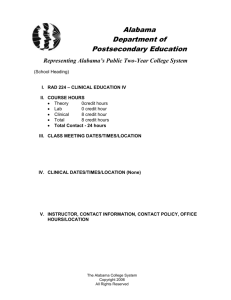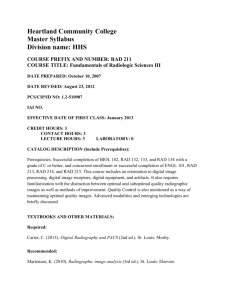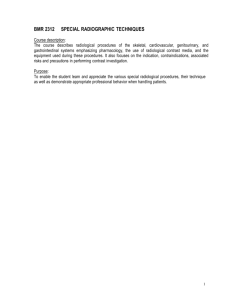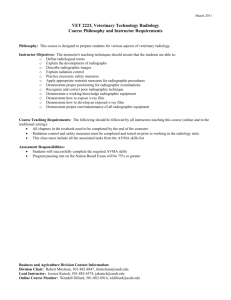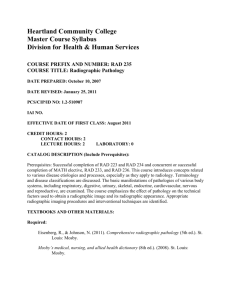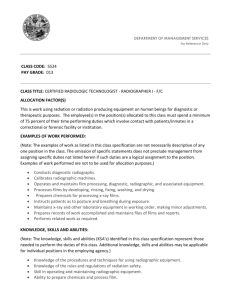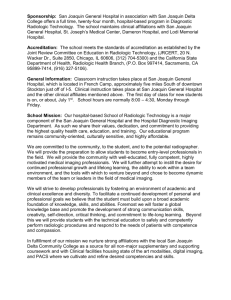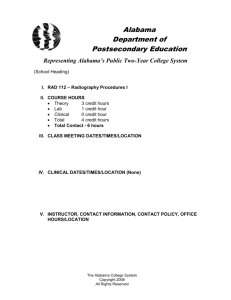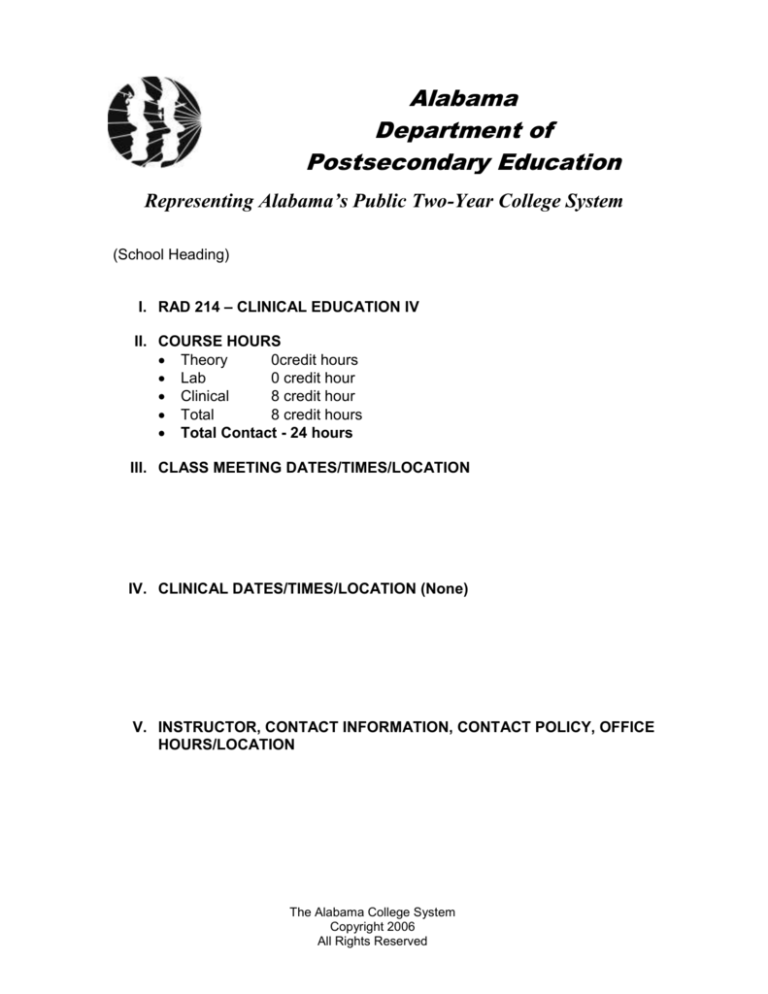
Alabama
Department of
Postsecondary Education
Representing Alabama’s Public Two-Year College System
(School Heading)
I. RAD 214 – CLINICAL EDUCATION IV
II. COURSE HOURS
Theory
0credit hours
Lab
0 credit hour
Clinical
8 credit hour
Total
8 credit hours
Total Contact - 24 hours
III. CLASS MEETING DATES/TIMES/LOCATION
IV. CLINICAL DATES/TIMES/LOCATION (None)
V. INSTRUCTOR, CONTACT INFORMATION, CONTACT POLICY, OFFICE
HOURS/LOCATION
The Alabama College System
Copyright 2006
All Rights Reserved
Clinical Education IV
RAD 214
VI. COURSE DESCRIPTION:
This course provides students with the opportunity to correlate previous
instruction with applications in the clinical setting. Students will be under
the direct supervision of a qualified practitioner. Practical experience in a
clinical setting enables students to apply theory presented thus far and to
practice radiographic equipment manipulation, radiographic exposure,
routine radiographic positioning, identification, and patient care
techniques. Principles of computed tomography and cross-sectional
anatomy will be presented. Upon completion of the course, students will
demonstrate practical applications of radiographic procedures presented
in current and previous courses.
VII. PREREQUISITE(S)/CO-REQUISITE(S)
CO-REQUISITE COURSES
PROFESSIONAL COMPETENCIES
VIII. TEXTBOOK(S) AND OTHER LEARNING RESOURCES
ACS Copyright 2006
All Rights Reserved
2
Clinical Education IV
RAD 214
IX. PROFESSIONAL COMPETENCIES/OBJECTIVES
MODULE A - CLINICAL PERFORMANCE EVALUATION
A1.0 Perform radiographic procedures.
A1.1 In a clinical environment perform radiographic activities.
A1.1.1
Learning objectives are evaluated in courses
associated with this course.
A2.0 Value the importance of following procedures associated with
providing radiographic services.
A2.1 This competency is measured affectively.
MODULE B – COMPUTED TOMOGRAPHY
B1.0 Explain the basic principles of image formation in computed
tomography (CT).
B1.1 This competency is measured cognitively.
B1.1.1
Define terms associated with CT.
B1.1.2
Describe events leading to development of
computed tomography and its evolution.
B1.1.3
Describe the components of the CT imaging
system.
B1.1.4
Define the heat load capacity of the radiographic
tube and explain what it means in both
conventional and spiral/helical CT scanning.
B1.1.5
Explain the functions of collimators in CT.
B1.1.6
Explain the location and function of detectors used
in CT systems.
B1.1.7
Describe the functions of the data acquisition
system (DAS).
B1.1.8
List the CT computer data processing steps.
B1.1.9
Name the functions of the array processor used
for image reconstruction.
B1.1.10 Explain how algorithms impact image scan factors
and reconstruction.
B1.1.11 Differentiate between “raw data” and “image data.”
B1.1.12 Differentiate between reconstructing and
reformatting an image.
B1.1.13 Describe the common controls found on CT
operator consoles.
B1.1.14 List the types of artifacts.
B1.1.15 Describe the appearance of artifacts that most
commonly affecting CT images.
B1.1.16 Describe current data storage techniques used in
CT.
B1.1.17 Differentiate between conventional and
spiral/helical CT scanning.
ACS Copyright 2006
All Rights Reserved
3
Clinical Education IV
RAD 214
MODULE C – CROSS-SECTIONAL ANATOMY
C1.0 Identify radiographic sectional anatomy.
C1.1 This competency is measured cognitively.
C1.1.1
Identify anatomical/positioning planes.
C1.1.2
Identify directional terms to describe the relative
position of one body part to another.
C1.1.3
Define regional terms.
C1.1.4
Formulate specific clinical considerations for each
transverse plane, sagittal plane, or coronal plane.
C1.1.5
Describe anatomical structures.
C1.1.6
Describe sectional anatomy of specified regions.
ACS Copyright 2006
All Rights Reserved
4
Clinical Education IV
RAD 214
X. OUTLINE OF MODULES
COURSE OUTLINE
MODULE A - CLINICAL PERFORMANCE AND EVALUATION
Requisition evaluation
Patient assessment
Room preparation
Patient management
Equipment operation
Technique selection
Position skills
Radiation safety
Image processing
Image evaluation
MODULE B – COMPUTED TOMOGRAPHY
Terms and definitions - Includes but not limited to:
o X, Y, Z coordinates
o Scan field of view (sfov)
o Display field of view (dfov)
o Linear attenuation coefficient
o CT/Hounsfield number
o Partial volume number
o Window width (ww) and window level (wl)
o Spatial resolution
o Contrast resolution
o Noise
o Annotation
o Region of interest (ROI)
o Algorithm
o Raw data
o Image data
o Artifacts
Evolution of CT
CT imaging system components
o Collimators
o Detectors
o Control console
o Table
o Gantry
o Tubes
Heat load capacity
Data acquisition system
Data processing steps
Array processors
ACS Copyright 2006
All Rights Reserved
5
Clinical Education IV
RAD 214
Algorithms
Raw data vs. image data
Artifacts
o Types
o Appearance
Data storage techniques
Conventional vs. spiral/helical CT scanning
MODULE C - CROSS-SECTIONAL ANATOMY
Anatomical/Positional planes
o Transverse
o Coronal
o Sagittal
o Midsaggital
o Parasagittal
o Frontal
Regional terms
Anatomical structures
Sectional anatomy
o Head
o Neck
o Vertebral Column
o Thorax
o Abdomen
o Pelvis
o Upper Extremity
o Lower Extremity
ACS Copyright 2006
All Rights Reserved
6
Clinical Education IV
RAD 214
XI. EVALUATION AND ASSESSMENT
ACS Copyright 2006
All Rights Reserved
7
Clinical Education IV
XII.
RAD 214
ATTENDANCE
a. Students are expected to attend all classes for which they are
registered. Students who are unable to attend class regularly,
regardless of the reason or circumstance, should withdraw from that
class before poor attendance interferes with the student’s ability to
achieve the objectives required in the course. Withdrawal from class
can affect eligibility for federal financial aid. Withdrawal from class
can prohibit progression in nursing and allied health programs.
b. Students are expected to attend all clinical rotations required for each
course. Only excused absences will be considered for make up.
However, due to limited clinical space and time, clinical make up days
cannot be guaranteed.
Failure to complete clinical rotations will
prohibit progression in nursing and allied health programs.
XIII.
STATEMENT ON DISCRIMINATION/HARASSMENT
The College and the Alabama Board of Education are committed to
providing both employment and educational environments free of
harassment or discrimination related to an individual’s race, color, gender,
religion, national origin, age, or disability. Such harassment is a violation
of State Board of Education policy. Any practice or behavior that
constitutes harassment is a violation of State Board of Education policy.
Any practice or behavior that constitutes harassment or discrimination will
not be tolerated.
XIV.
AMERICANS WITH DISABILITIES
The Rehabilitation Act of 1973 (Section 504) and the American with
Disabilities Act of 1990 state that qualified students with disabilities who
meet the essential functions and academic requirements are entitled to
reasonable accommodations. It is the student’s responsibility to provide
appropriate disability documentation to the College. Please contact the
ADA representative.
ACS Copyright 2006
All Rights Reserved
8
Clinical Education IV
XV.
RAD 214
COURSE CALENDAR
ACS Copyright 2006
All Rights Reserved
9
Clinical Education IV
XVI.
RAD 214
STUDENT ACKNOWLEDGEMENT FORM
ACS Copyright 2006
All Rights Reserved
10


